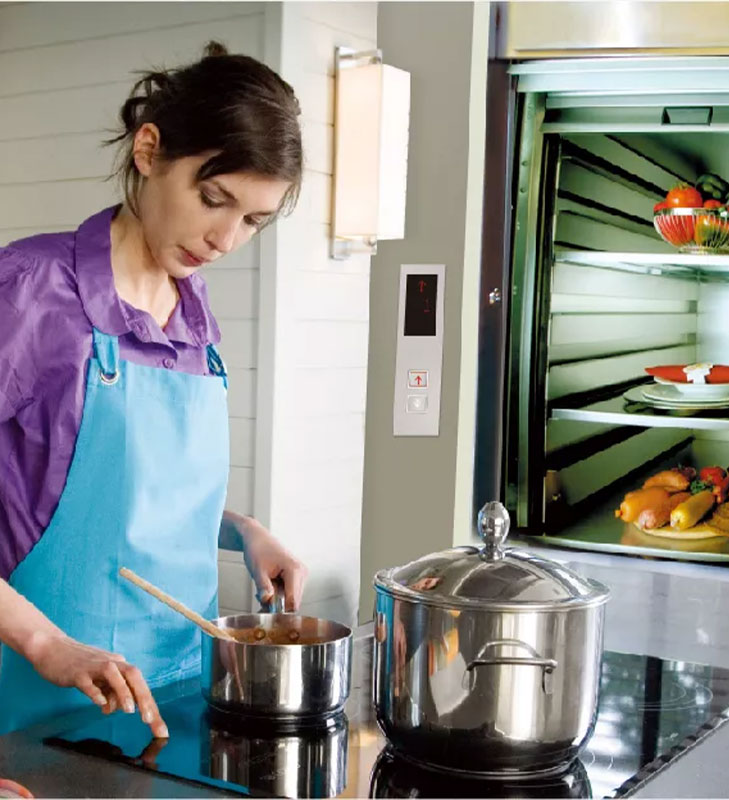As an efficient and convenient vertical transportation equipment, Dumbwaiter Elevators are widely used in multi-story space scenes such as restaurants, hotels, hospitals, and homes. With the continuous improvement of users' requirements for user experience, modern small food elevators not only focus on transportation efficiency, but also continuously optimize structural design and intelligent control systems to achieve higher safety, operation stability and low noise performance. So, how do these devices take into account these three aspects and improve overall performance?
In terms of structural design, modern small food elevators adopt modular and lightweight design concepts to achieve the best layout in a limited space. Traditional elevators often require a large shaft space, while the new Dumbwaiter Elevators use a compact guide rail system and a machine room-free or small machine room structure, which greatly reduces the installation space requirements, especially suitable for kitchens, villas and other space-constrained environments. At the same time, the elevator body is mostly made of high-strength aluminum alloy or stainless steel, which not only improves the overall structural strength, but also effectively reduces vibration and noise during operation.
The upgrade of the drive system is the key to achieving stable operation. At present, the mainstream small food delivery elevators generally use permanent magnet synchronous traction machines or screw drive systems. Compared with traditional chain or belt drive methods, their operation is smoother, more accurate, and less noisy. In addition, some high-end products are also equipped with variable frequency speed regulation technology, which enables the elevator to maintain a soft transition during start-up, acceleration, deceleration and stop, reducing the sense of impact, thereby further improving the comfort and stability of operation.
Intelligent control systems provide a strong guarantee for the safety and convenience of elevator operation. Modern dumbwaiter elevators are usually equipped with PLC programmable controllers or microcomputer control systems, which can monitor the operation status of the elevator in real time and automatically adjust the operation parameters according to load changes. For example, when overload is detected or the door is not completely closed, the system will automatically alarm and prohibit operation to prevent accidents. In addition, many products also support functions such as floor calls, voice prompts, and remote control, which greatly improves the user's operating experience and management efficiency.

In terms of safety protection, small food delivery elevators also have multiple protection mechanisms. In addition to conventional limit switches and emergency stop buttons, some models are also equipped with infrared sensors or photoelectric protection systems to ensure that there will be no damage or accidents caused by foreign objects or misoperation during the operation of the elevator. For food delivery elevators used in homes or hospitals, humanized functions such as child safety locks and anti-pinch designs can also be selected to improve overall safety.
In addition, manufacturers have optimized the noise control problem from multiple levels. On the one hand, low-noise motors and shock-absorbing rubber pads are selected to reduce noise transmission from the source; on the other hand, sound insulation materials are added to the inside of the box to reduce metal collision sounds and resonance effects. Some high-end models also introduce sound-absorbing panels in the shaft structure, making the entire operation process almost silent, which is particularly suitable for family villas or multi-storey offices that have high requirements for a quiet environment.
Maintenance convenience is also an important factor in ensuring long-term stable operation. Most modern dumbwaiter elevators adopt modular component design, which is convenient for daily maintenance and replacement. At the same time, combined with the intelligent monitoring system, users can view the status of the equipment in real time through mobile phone APP or computer terminal, detect potential faults in advance, and avoid sudden downtime affecting normal use.
Dumbwaiter Elevators have successfully achieved safe, stable and low-noise operation while ensuring efficient transportation through scientific structural design, advanced drive system, intelligent control, multiple safety protection mechanisms and professional noise reduction processing. In the future, with the development of the Internet of Things and artificial intelligence technology, this type of equipment will continue to upgrade in terms of automation, remote operation and maintenance, and energy-saving performance, providing more intelligent and efficient vertical logistics solutions for commercial kitchens, high-end residences and medical institutions.











